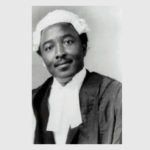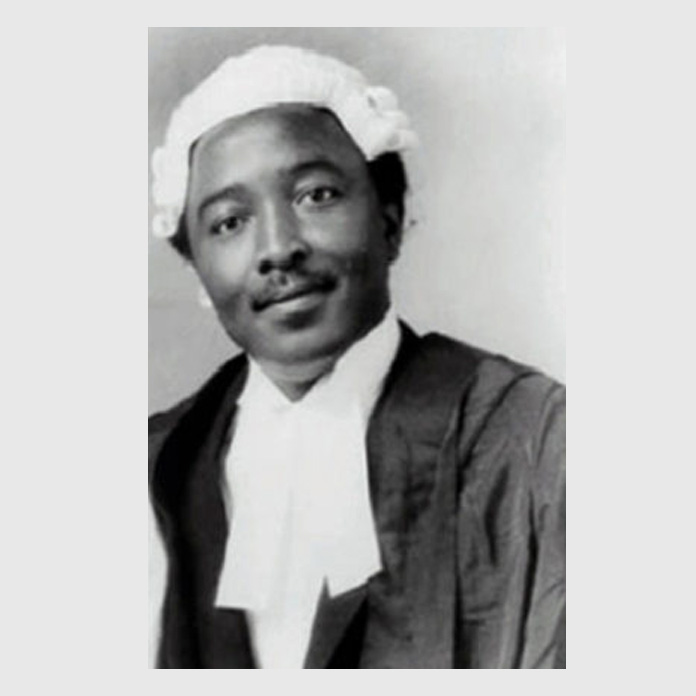

First published on July 30, 2001 – Sierra Leone Live
In this four-part article, John L. Musa shows whether or not Francis M. Minah was guilty of treason for the May 23, 1989 coup
Part 4- Verdict, Appeal, Sentences And My Commentary
THE TRIAL AND VERDICT IN THE HIGH COURT
After a protracted trial of five months in the High Court before Justice D.E. M. Williams, a 12-man jury returned a verdict of guilty as charged. Gabriel Mohamed Tennyson Kaikai and 15 others were convicted of treason and two of the 18 suspects were convicted of misprision of treason. During the trial 46 witnesses gave evidence for the prosecution, 22 testified for the defence and 44 exhibits were tendered and admitted in evidence.
KEY EXHIBITS: Trial Exhibit ZZZZQ (G.M. T. Kaikai’s would-be coup speech, tendered into evidence by N. D. Tejan Cole, Director of Public Prosecutions and identified by Detective Superintendent Seth Amedofo, 26th Prosecution witness).
Trial Exhibit JJJ (A statements allegedly made by Jamil Sahid Mohamed and Francis Minah in the presence of the First Accused in Jamil’s home).
Said Jamil: “BO HOW WUNA GOVERNMENT?” And retorted Minah: “Nor provoke me, enti you know say mi nar, ceremonial vice president.” The trial judge advised the jury to consider the two utterances as to whether they are the same as the ones made under oath by the First Accused.
When the jury returned its verdict of guilty as charged, Justice Williams sentenced the accused as follows:
SENTENCED TO DEATH FOR TREASON
Gabriel Mohamed Tennyson Kaikai (1st accused)
Prince Deen Kaikai (2nd accused)
Joseph John Harding (3rd accused)
Daniel Sulaiman Kaikai (4th accused)
Francis Misheck Minah (5th accused)
David Abu Samu (6th accused)
Francis Massaquoi (7th accused)
Francis Augustine Ensah (8th accused)
Amara Allieu Tarawallie (9th accused)
Josephus Abiodun Williams (10th accused)
Patrick Benedick Kaikai (11th accused)
Hassan Morlai Conteh (12TH accused)
Conrad Inis (13TH accused)
Kazim Hussain Allie (14TH accused)
Raymond Dowrie (15TH accused)
Harouna Vandy-Jimmy (16th accused)
GUILTY OF MISPRISION OF TREASON
Benjamin Orissa Dumacca Taylor, sentenced to four years in jail (17th accused) Sheku Deen Kamara, sentenced to seven years in jail (18th accused)
IN THE COURT OF APPEAL
On September 22, 1988, the resolution of the Court of Appeal was unanimously by a three-panel Bench of Justices Thompson Davies, William A.O. John Johnson and M.S. Turay as President. The Appeal Court upheld the trial court’s verdict of guilty and conformed the capital punishment of death by hanging for 12 of the convicts. The Court freed Francis Augustine Ensah, Kazim Hussain Allie, Patrick Kaikai, and Raymond Dowie. The four men were convicted in the High Court and sentenced to death. The death sentences of Francis minah and others were affirmed by the Court of Appeal. The four-year and seven-year terms of Benjamin Taylor and Sheku Deen Kamara were sustained by the Court.
IN THE SUPREME COURT
Craving to stave off the death penalty, the prisoners asked the Supreme Court to be the last umpire in the great contention of treason. While their fate was under resolution by the Supreme Court, they waited in vain expectation of the disposition of their sentences on the bases of questions of law which formed their appeal (the trial judge’s “misdirected” jury instructions, duplicitous indictments and vague charges, etc.). Among the questions of law, the appellants asked the Supreme Court to resolve was that Trial Court’s jury instructions and Justice D.E.M. Williams’ summing up amounted to a miscarriage of justice. Deliberating on this great contention was Chief Justice S.M.F. Kutubu and Justices Taju Deen, A.A. Timbo, Sydney Warne and Beccles Davies. The Court affirmed the legal bases of the lower courts and sustained the death sentences of the 12 treason convicts and the two-term years’ convictions of those found guilty of misprision of treason.
COMMITTEE ON THE PREROGATIVE OF MERCY
While this Committee was deliberating on whether or not to hang the 12 treason convicts, the prisoners were examined by a medical doctor in preparation for their hanging. West Africa Magazine reported at the time that the cabinet was divided on who was to be hanged. In the end, Minah’s lot fell with five others to be executed. The sentences of DEATH BY HANGING In the early morning hours of October 7, 1989, the following prisoners were hanged by the neck:
Gabriel Mohamed Tennyson Kaikai,
Prince Deen Kaikai,
Sulaiman Kaikai,
Francis Mischek Minah,
Conrad Inis
The hangings started in the death chamber at Central Prison at Pa Demba Road at 12 Mid-night and ended at 6 a.m.
SENTENCES TO LIFE IMPRISONMENT
David Abu Samu (6th accused)
Francis Massaquoi (7th accused)
Amara Allieu Tarawallie (9th accused)
Josephus Abiodun Williams (10th accused)
Hassan Morlai Conteh (12TH accused)
Harouna Vandi-Jimmy (16th accused)
FREED FOR LACK OF EVIDENCE
Francis Augustine Ensah (8th accused)
Patrick Benedick Kaikai (11th accused)
Kazim Hussain Allie (14TH accused)
Raymond Dowrie (15TH accused)
FINAL DELIBERATIONS
When Justice D.E.M. Williams asked the accused if they had anything to say before he pronounced his sentence, each suspect beginning with G.M.T. Kaikai said something of his innocence. When it was Minah’s turn, he said what was already known in that personal Kangaroo court to send him to perdition. “I CANNOT HELP BUT CONVINCE MYSELF THAT THIS IS AN ORCHESTRATED ALLEGATION THAT HAS BEEN LEVIED AGAINST ME TO GET RID OF ME.”
By engaging in a seeming quest to settle scores for Minah’s iniquitous actions as a politician, supporters of Minah could feel the emotion of LEX TALIONIS, the principle of exacting an eye for an eye, and in this case for a false accusation. T.S. Eliot said it best: ” a situation, a chain of events… such that when the external facts, which must terminate in sensory experience are given, the emotion is immediately evoked.”
The development of arbitrary and capricious application of the Treason law of Sierra Leone is impressive. As the Minah treason trial shows, the catchpenny trick of bad prosecution in the treason trial under review is not reconcilable with the rule of law. From the Forna trumped up treason charges, the Minah Kangaroo Court, to the Drumhead of the NPRC, the Superior Court of Judicature of Sierra Leone has become a haunted house by ghosts of departures from the rule of law. And when treason allegations are preferred falsely, and when such political trials have upset our faith in democracy and equal protection for both ordinary criminal suspects and politicians covered with ignominy in our society, the foundations of the rule of law are shaken. What is more, the High Court of Sierra Leone becomes a forum for vendetta instead of judicial equity.
The Superior Court of Judicature of Sierra Leone should remain a forum that is a shield of protection for all classes of persons in all circumstances that assures the continuity of the rule of law. When it acts otherwise, the privileges and grants of constitutional liberty to Sierra Leoneans now and over the ages will become a munificent bequest in a pauper’s will. Such a legacy when ignored, rises in our national breasts as the spirit of the age and we make a model of it to make calumny and groundless accusations against compatriots! In that regard, we often hear that this compatriot committed treason or committed another felony without asking the Director of Public Prosecutions to prefer charges. Prattling without evidence is a mere sport! It should be avoided by well-meaning compatriots with the seriousness of purpose.
Best regards,
John Lansana Musa (R.I.P) Brother!
Thanks for following this presentation of ;
Was Francis M. Minah Guilty of Treason?



